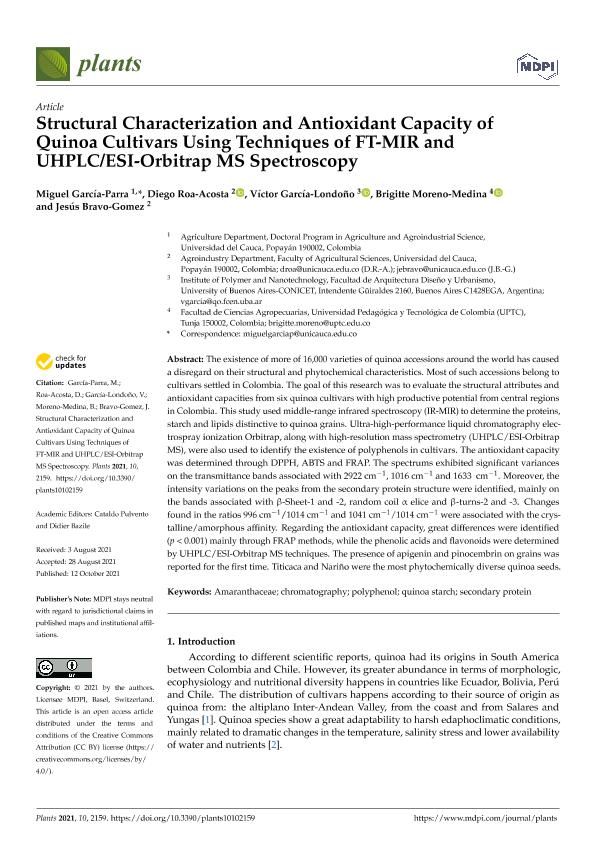Artículo
Structural Characterization and Antioxidant Capacity of Quinoa Cultivars Using Techniques of FT-MIR and UHPLC/ESI-Orbitrap MS Spectroscopy
García Parra, Miguel Angel; Roa Acosta, Diego Fernando ; García Londoño, Víctor Alonso
; García Londoño, Víctor Alonso ; Moreno Medina, Brigitte; Bravo Gomez, Jesús
; Moreno Medina, Brigitte; Bravo Gomez, Jesús
 ; García Londoño, Víctor Alonso
; García Londoño, Víctor Alonso ; Moreno Medina, Brigitte; Bravo Gomez, Jesús
; Moreno Medina, Brigitte; Bravo Gomez, Jesús
Fecha de publicación:
10/2021
Editorial:
MDPI
Revista:
Plants
ISSN:
2223-7747
Idioma:
Inglés
Tipo de recurso:
Artículo publicado
Clasificación temática:
Resumen
The existence of more of 16,000 varieties of quinoa accessions around the world has caused a disregard on their structural and phytochemical characteristics. Most of such accessions belong to cultivars settled in Colombia. The goal of this research was to evaluate the structural attributes and antioxidant capacities from six quinoa cultivars with high productive potential from central regions in Colombia. This study used middle-range infrared spectroscopy (IR-MIR) to determine the proteins, starch and lipids distinctive to quinoa grains. Ultra-high-performance liquid chromatography electrospray ionization Orbitrap, along with high-resolution mass spectrometry (UHPLC/ESI-Orbitrap MS), were also used to identify the existence of polyphenols in cultivars. The antioxidant capacity was determined through DPPH, ABTS and FRAP. The spectrums exhibited significant variances on the transmittance bands associated with 2922 cm−1, 1016 cm−1 and 1633 cm−1. Moreover, the intensity variations on the peaks from the secondary protein structure were identified, mainly on the bands associated with β-Sheet-1 and-2, random coil α elice and β-turns-2 and-3. Changes found in the ratios 996 cm−1/1014 cm−1 and 1041 cm−1/1014 cm−1 were associated with the crys-talline/amorphous affinity. Regarding the antioxidant capacity, great differences were identified (p < 0.001) mainly through FRAP methods, while the phenolic acids and flavonoids were determined by UHPLC/ESI-Orbitrap MS techniques. The presence of apigenin and pinocembrin on grains was reported for the first time. Titicaca and Nariño were the most phytochemically diverse quinoa seeds.
Palabras clave:
AMARANTHACEAE
,
CHROMATOGRAPHY
,
POLYPHENOL
,
QUINOA STARCH
,
SECONDARY PROTEIN
Archivos asociados
Licencia
Identificadores
Colecciones
Articulos(ITPN)
Articulos de INSTITUTO DE TECNOLOGIA EN POLIMEROS Y NANOTECNOLOGIA
Articulos de INSTITUTO DE TECNOLOGIA EN POLIMEROS Y NANOTECNOLOGIA
Citación
García Parra, Miguel Angel; Roa Acosta, Diego Fernando; García Londoño, Víctor Alonso; Moreno Medina, Brigitte; Bravo Gomez, Jesús; Structural Characterization and Antioxidant Capacity of Quinoa Cultivars Using Techniques of FT-MIR and UHPLC/ESI-Orbitrap MS Spectroscopy; MDPI; Plants; 10; 10; 10-2021; 1-15
Compartir
Altmétricas



